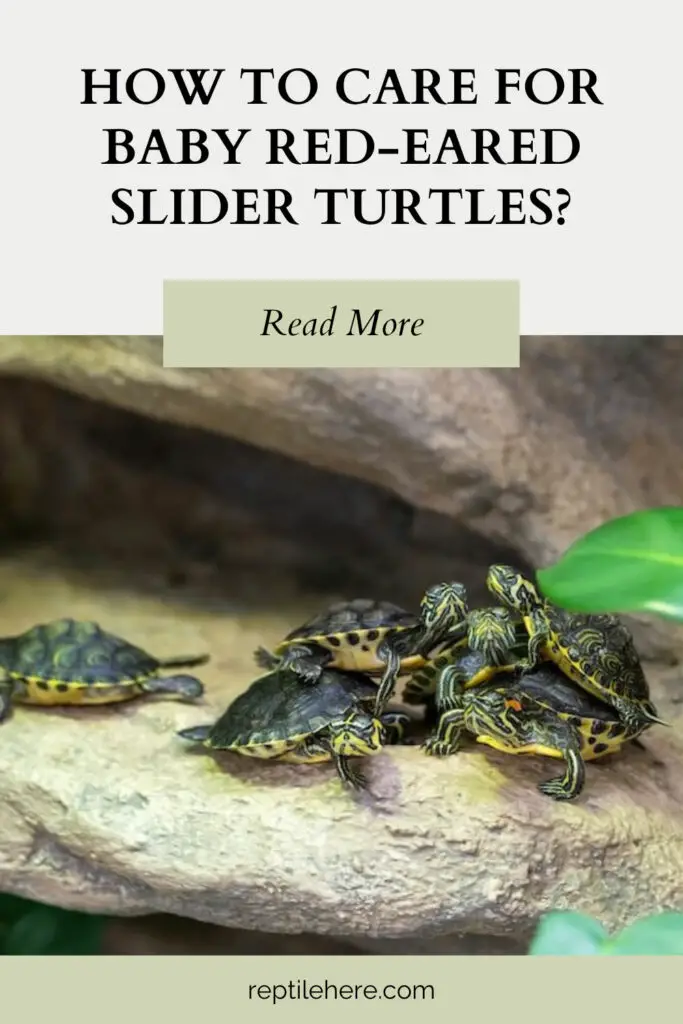How To Care For Baby Red-Eared Slider Turtles
If you just go yourself a baby red-eared slider but you’re clueless about how to take care of it, you’ve come to the right place. This article will give you helpful advice and tips for taking care of your baby slider.
To care for a baby red-eared slider turtle, you’ll need to provide it with a suitable habitat with a basking spot, powerful filtration, and adequate UVB lighting. You’ll also need to provide your baby slider with a balanced diet and take it to the vet for regular checkups and vaccinations.
Our guide below will teach you everything you need to know about taking proper care of your baby red-eared slider from choosing the right enclosure to tank setup, keeping the tank clean, proper diet, and so much more.
How to care for baby red-eared slider turtles
Contents
Baby slider turtles need slightly more specialized care to survive than adults since they’re pretty fragile in their early life.
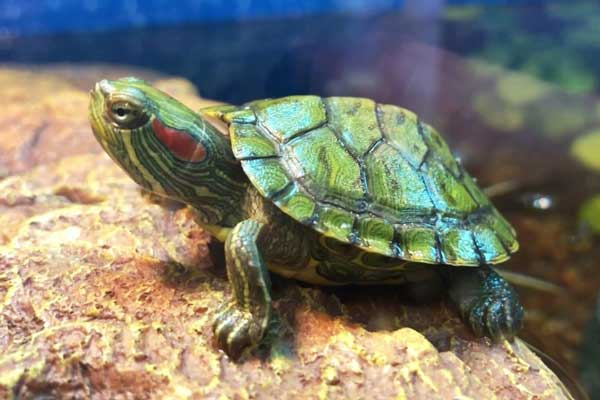
Here’s the complete care guide for baby red-eared slider turtles:
Choosing the right baby red-eared slider turtle enclosure
Baby red-eared slider turtles usually require a 30 to 50-gallon tank. But keep in mind that baby turtles grow pretty fast and reach adult size in about 1-2 years. At this point, you’ll need to upgrade its tank to around 75 to 100 gallons for the large-sized adult slider.
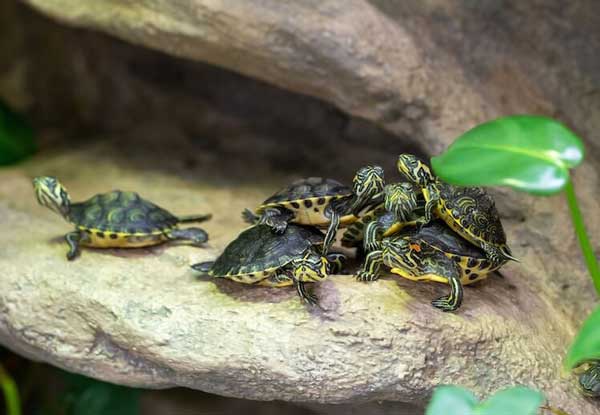
You can opt to house your turtle in a smaller temporary tank and then transfer them to a larger tank once they reach adult size. Or you can get the large tank from the word go. We suggest going with the latter option as it will help you save money early on.
Baby red-eared slider turtle tank setup
Once you’ve got the right type of enclosure for your turtle, you’ll now need to set it up to make it a comfortable living space for your baby slider.
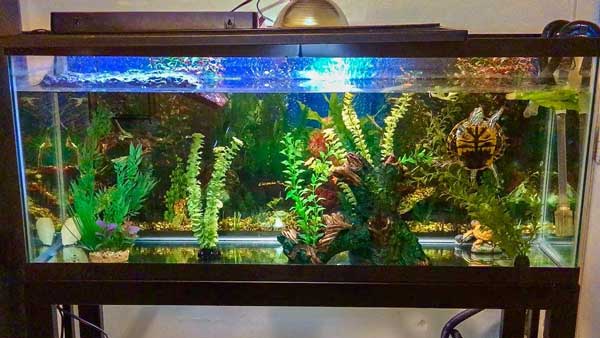
The perfect habitat for your red-eared slider baby turtle requires the following:
- Basking platform: you should provide your baby turtle with a comfortable dry area for drying off, resting, and taking in UV rays. Ensure the basking area is easily accessible. Also, equip the area with a heat lamp to maintain proper air temperature.
- Lighting: You should also equip the basking area with full spectrum UV lighting for about 12 hours every day. This is crucial for your turtle’s health as it helps promote calcium absorption for proper shell and bone development.
- Temperature: The recommended baby red-eared slider water temperature is 75 to 85 degrees F while the basking area temperature should be 85 to 90 degrees F.
- Substrate: This is optional but helps beautify your turtle aquarium. You may consider rock, gravel, or slate. Use rocks/gravel that aren’t too small for your turtle to ingest as it can lead to impaction issues.
- Décor: This is also optional but helps further improve your turtle tank aesthetics and make it more interesting for your baby turtle. Examples of decor to consider include live/fake plants, hide spots, rocks, etc.
- Water filter: Your baby turtle defecates and eats in water, so its tank can get dirty pretty fast. Installing a strong canister filter will help remove the waste from the water and keep the tank clean.
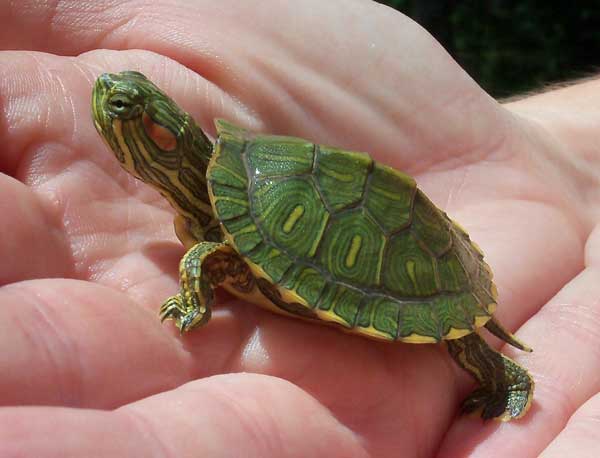
Keep the turtle enclosure clean
Proper maintenance of the habitat you’ve just set up in the previous step is part of taking proper care of your turtle.
Essentially, you’ll just need to keep the tank clean for the sake of your turtle’s health. Remember, baby turtles are easily susceptible to various health issues as their immune is weak and still developing.
Luckily, having a powerful filter in place will help trap the turtle waste and remove it from the water, keeping your water clean for longer periods of time.
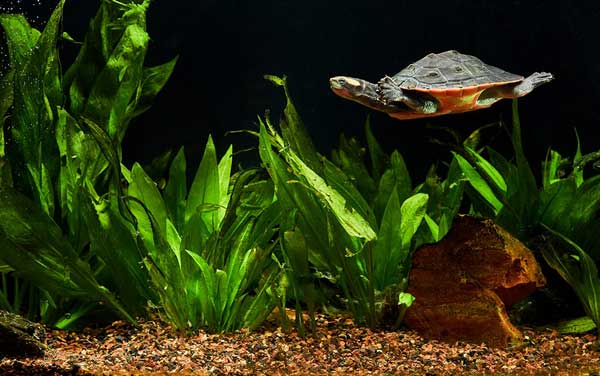
Keep an eye on your filter and the turtle enclosure and clean it every 3-4 weeks.
You’ll also need to do partial water changes to keep the tank clean and free of harmful bacteria that make your turtle sick.
What to feed a baby red-eared slider turtle
Red-eared sliders are omnivorous and a balanced diet for them involves both plant and animal materials.
However, your baby red-eared slider requires more protein in its diet to help support its growth and development.
Some of the favorite foods for your baby red-eared slider turtle include shrimps, earthworms, mealworms, aquatic snails, crickets, etc.
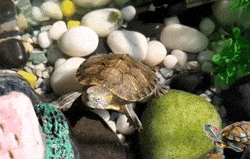
Don’t forget to give them some veggies, dark leafy greens, and fruits as well.
You may also consider buying your young slider vitamin D3 and calcium supplements. These will help boost its shell and bone development and growth.
Don’t forget to take him for regular vet checkups
The first day you bring your baby slider home, make sure you take him to the vet as soon as possible.
Afterward, you should take him for checkups annually, though you can also do it twice a year if you can afford to. This will help catch any potential illnesses early on before they can turn severe.
Some of the common health problems for baby red-eared sliders include respiratory infections, calcium deficiency, parasitic infections, etc.
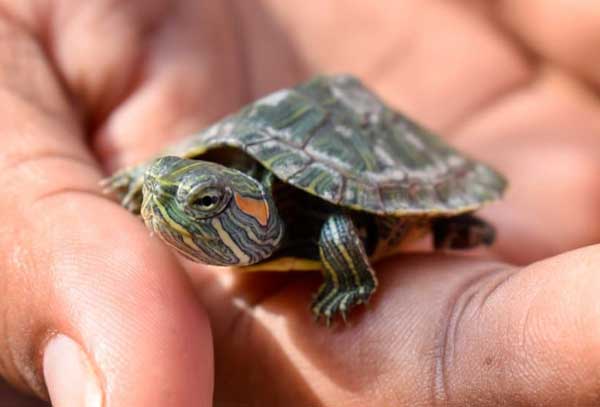
These can be prevented with proper living conditions for your pet and providing a healthy and nutritious diet.
Regular vet checkups can also help detect and treat these diseases in their early stages.
How do you handle your baby red-eared slider?
You should avoid handling your baby slider as much as possible unless it’s absolutely necessary. These little animals carry germs and salmonella which can make you sick easily.
Make sure you thoroughly wash your hands after handling the turtle. The turtles are also not adaptable to handling and can get easily scared and stressed.
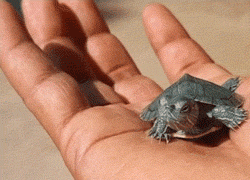
When handling your red-eared slider, set the thumb and first finger of both hands in a pinching style. One hand should go on either side of your baby turtle while the thumbs go to the shell bottom.
Avoid squeezing your turtle when holding it in your hands. Hold your baby turtle for not more than just 5 minutes.
How often should I feed my baby red-eared slider?
You should feed your baby red-eared slider once every day. The baby sliders have faster metabolism rates than their adult relatives, hence the need to eat more frequently.
While adults can survive by eating 2-3 times every week, baby turtles will need to be fed every day.
However, after your turtle hits 6 months, you can adjust the feeding frequency, say to about every other day.
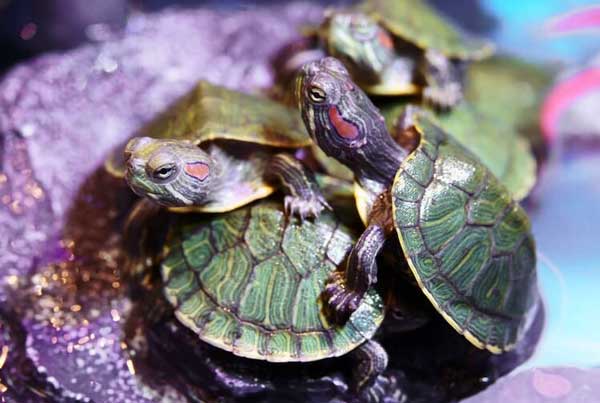
The quantity of food you feed your turtle also matters. We recommend giving your pet turtle the amount of food it can eat within 10-15 minutes.
Be sure to break the food items into small bids to prevent the possibility of your turtle choking.
Why is your baby red-eared slider not eating?
The most possible reason why your baby red-eared slider isn’t eating is due to stress that comes from being introduced to a new environment.
If your baby doesn’t eat even after around 3-4 days, then you should be concerned. Check if the living conditions are good, including the water quality, lighting, and temperatures.
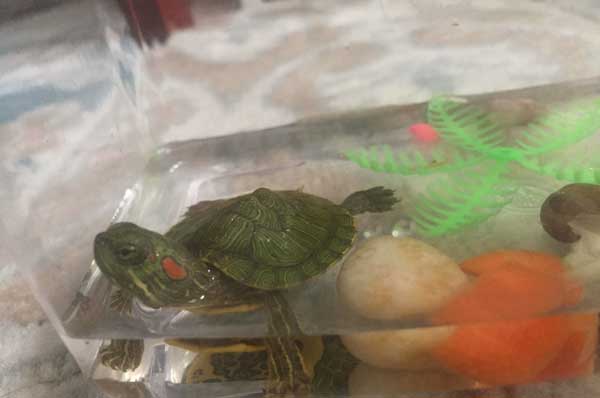
If the tank looks ok, check the food you offer your slider. It may not be interested in the food yore offering it. Try offering your turtle varieties to see what it likes.
If your turtle still won’t eat, then it’s time to consult your vet!
FAQs:
Tiny turtles less than 4 inches are generally illegal to sell in the US under federal law as they carry salmonella which can make you sick. This includes baby red-eared sliders. However, we recommend checking your local guidelines to see if you can own a baby slider in your area.
Absolutely! The baby red-eared sliders’ tank water should be maintained at temperatures between 75 and 85 degrees F. Their cold-blooded nature means they require warm water at the mentioned temperature for them to survive. Otherwise, if subjected to cold water, they can get too cold and even die!
The key signs of a healthy baby red-eared slider include being alert and active, healthy skin without sores, regular feeding, healthy and hard shell with no lesions, clear vent and nose, and clear, bright eyes with no discharge.
Overall, if your slider has a sudden change of its normal behavior, then you should be concerned as it could be a sign that something is off with its body.
Final Verdict
Taking proper care of your baby red-eared slider turtle boils down to minding its housing, diet, and health. You should provide your turtle with a suitable housing that mimics its natural habitat, feed it a balanced diet that contains more animal proteins than plant materials, and take it to the vet for regular checkups to keep its health in check.
We hope that the information shared in this guide has given you helpful insights on how to take good care of your baby red-eared slider turtle, including setting up proper housing, giving it the right diet, maintaining a clean environment, and the key signs to look for in a healthy turtle.
